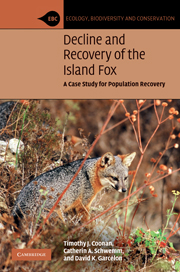Book contents
- Frontmatter
- Contents
- Foreword
- Acknowledgments
- 1 Introduction
- 2 Evolution and genetics
- 3 Social structure, reproduction, mortality and survivorship, and population dynamics
- 4 Food habits, habitat use, activity patterns, and dispersal
- 5 Golden eagles and the decline on the northern islands
- 6 Ecosystem recovery
- 7 Disease and decline on Santa Catalina Island
- 8 Recovery actions
- 9 Recovery actions
- 10 Reproductive biology, by Cheryl Asa
- 11 Diseases of island foxes, by Linda Munson
- 12 Zoos, education, and public participation
- 13 Managing recovery
- 14 The ecological role of island foxes
- 15 Conclusion
- References
- Index
7 - Disease and decline on Santa Catalina Island
Published online by Cambridge University Press: 05 October 2010
- Frontmatter
- Contents
- Foreword
- Acknowledgments
- 1 Introduction
- 2 Evolution and genetics
- 3 Social structure, reproduction, mortality and survivorship, and population dynamics
- 4 Food habits, habitat use, activity patterns, and dispersal
- 5 Golden eagles and the decline on the northern islands
- 6 Ecosystem recovery
- 7 Disease and decline on Santa Catalina Island
- 8 Recovery actions
- 9 Recovery actions
- 10 Reproductive biology, by Cheryl Asa
- 11 Diseases of island foxes, by Linda Munson
- 12 Zoos, education, and public participation
- 13 Managing recovery
- 14 The ecological role of island foxes
- 15 Conclusion
- References
- Index
Summary
The events that led to the near-extinction of island foxes on Santa Catalina Island were coincident in time with the declines in the north, but were ecologically unrelated. While the cause of northern island mortalities was predation, on Santa Catalina it was disease that was introduced to the island ecosystem most probably by a raccoon (Procyon lotor) or domestic dog infected with canine distemper virus (CDV) that was brought intentionally or by accident to the island. Santa Catalina is the only one of the eight Channel Islands with permanent residents, and Avalon, the only town, has a year-round population of over 3,500 and over 1 million tourists that visit mostly in the summer. Along with humans have come their pets, and the wild species associated with human habitations such as rats and raccoons. Santa Catalina's natural resources are managed by the non-profit Catalina Island Conservancy (‘Conservancy’), and the recovery efforts and conservation of island foxes on Santa Catalina were coordinated by the Conservancy and their primary contractor, IWS. In 1999 the fox population on Santa Catalina declined by > 90% due to CDV, a disease for which at the time there was no tested vaccination for use in wild animals. Consequently a new set of strategies and responses was needed to address this second but also unique threat to island foxes.
- Type
- Chapter
- Information
- Decline and Recovery of the Island FoxA Case Study for Population Recovery, pp. 73 - 80Publisher: Cambridge University PressPrint publication year: 2010
- 1
- Cited by



